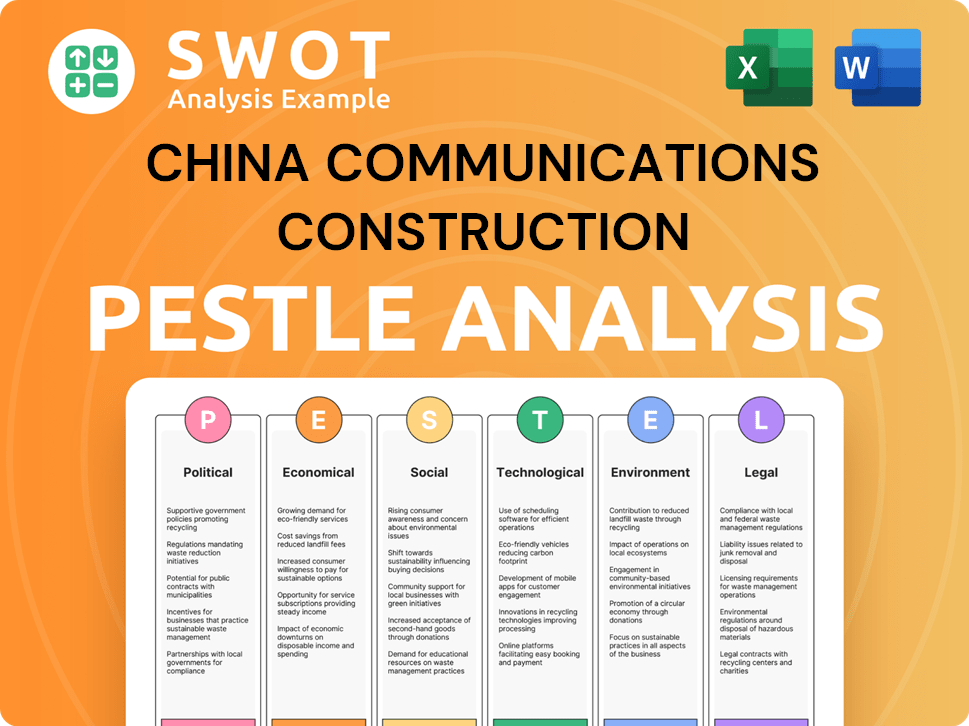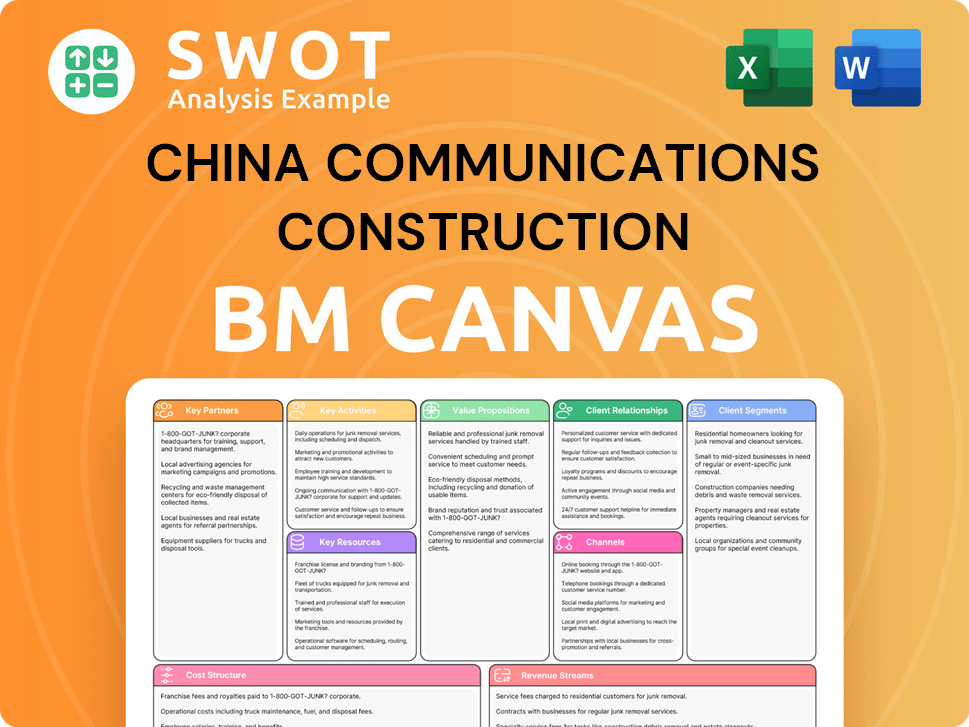China Communications Construction Bundle
Can CCCC Maintain Its Dominance in the Global Infrastructure Race?
China Communications Construction Company (CCCC) is a powerhouse in global infrastructure, fueled by China's expansive Belt and Road Initiative and domestic growth. As of early 2024, CCCC leads in designing and constructing vital infrastructure like transportation networks and port facilities. Its influence spans continents, shaping global trade and connectivity through ambitious infrastructure projects.

Understanding the China Communications Construction SWOT Analysis is crucial to grasping CCCC's position. This deep dive into the competitive landscape will identify key rivals and analyze CCCC's unique strengths. We'll explore the challenges and opportunities facing CCCC, providing a comprehensive market analysis of its strategies and performance within the dynamic world of infrastructure projects and Chinese construction companies.
Where Does China Communications Construction’ Stand in the Current Market?
CCCC holds a significant position in the global infrastructure construction market. The company is a leading player, particularly in its core segments. Its operations cover the entire lifecycle of infrastructure projects, from planning and design to construction and maintenance.
The company's primary focus is on infrastructure projects, serving governments, public-private partnerships, and large industrial clients. CCCC's strategic shift includes expansion into areas like environmental engineering and urban development, reflecting a diversification of offerings. Marketing Strategy of China Communications Construction provides further insights into the company's approach.
CCCC consistently ranks among the top international contractors. In 2023, it maintained its position as the world's largest port design and construction company and the largest dredging company, ranking as the third-largest international contractor by revenue.
CCCC has a substantial global presence, with projects and operations in over 150 countries and regions. This extensive reach allows the company to undertake large-scale infrastructure projects worldwide. Its international footprint is a key factor in its market position.
CCCC provides a comprehensive suite of services across the infrastructure lifecycle. This includes planning, design, construction, operation, and maintenance. This integrated approach enhances its ability to manage complex projects and meet diverse client needs.
CCCC demonstrates strong financial health and scale. The company reported a year-on-year increase in operating income as of the third quarter of 2024, indicating sustained growth. This financial strength supports its ability to undertake large projects and compete effectively.
CCCC primarily serves government entities, public-private partnerships, and large industrial clients. This focus allows the company to target major infrastructure projects. The company's ability to secure and execute these projects is a key indicator of its market position.
CCCC's strengths are evident in port and road construction. However, its position in niche or highly specialized segments might be less dominant compared to dedicated global players. The company's ongoing diversification efforts and strategic focus will likely impact its competitive landscape.
- Market Leadership: CCCC's leadership in port design and construction, and dredging, is a significant competitive advantage.
- Global Presence: Operations in over 150 countries provide a broad base for project opportunities.
- Financial Stability: Consistent revenue growth and strong financial performance support large-scale project execution.
- Diversification: Expansion into environmental engineering and urban development broadens its market reach.
China Communications Construction SWOT Analysis
- Complete SWOT Breakdown
- Fully Customizable
- Editable in Excel & Word
- Professional Formatting
- Investor-Ready Format

Who Are the Main Competitors Challenging China Communications Construction?
The competitive landscape for China Communications Construction Company (CCCC) is multifaceted, encompassing both domestic and international players across various infrastructure and construction sectors. The company, often referred to as CCCC, faces intense competition from both Chinese state-owned enterprises (SOEs) and global construction giants. Understanding these competitors is crucial for a comprehensive market analysis and for assessing CCCC's strategic positioning.
CCCC's competitive environment is shaped by factors such as project scale, government backing, technological capabilities, and adherence to international standards. The company's involvement in the Belt and Road Initiative (BRI) further intensifies competition, as it bids for major contracts in numerous countries. Examining the strengths and weaknesses of its rivals provides insights into the challenges and opportunities CCCC faces in maintaining and expanding its market share.
The Brief History of China Communications Construction highlights the company's evolution and its increasing presence in the global construction market, which has led to more intense competition. This competition is not only about winning contracts but also about adapting to new technologies and sustainability standards.
Within China, CCCC's primary competitors are other large SOEs. These firms often compete on similar projects, leveraging their scale and government support.
The competition is particularly fierce in large-scale infrastructure projects, both domestically and internationally.
CSCEC is a major competitor, frequently vying for large building and infrastructure projects. CSCEC's extensive portfolio includes residential, commercial, and industrial projects.
CSCEC's strong domestic presence and international expansion capabilities make it a direct rival to CCCC.
CREC and CRCC are key players in railway and urban transit projects. These companies have a strong focus on railway construction and related infrastructure.
They are significant competitors in the transportation infrastructure sector, both in China and abroad.
CCCC competes with several international construction companies. These companies often have advanced technological capabilities and established supply chains.
They also compete on adherence to international environmental and labor standards.
Vinci is a global construction and concessions company. Vinci has a diverse portfolio, including infrastructure, energy, and concessions.
Vinci competes with CCCC on large-scale infrastructure projects worldwide.
Bechtel is a major player in engineering, procurement, and construction. Bechtel's projects range from infrastructure to energy and resources.
Bechtel's global presence and project management expertise make it a significant competitor.
The competitive landscape also includes companies specializing in specific sectors. For instance, in the dredging sector, CCCC's subsidiary, China Harbour Engineering Company (CHEC), competes with global leaders like Jan De Nul Group (Belgium) and Boskalis (Netherlands). These companies are known for their specialized equipment and expertise in complex marine engineering projects. In heavy machinery manufacturing, CCCC faces competition from global players like Konecranes, Liebherr, and various Chinese manufacturers like Sany and XCMG. The competitive landscape is further influenced by mergers and alliances, such as joint ventures formed by international players to bid on large, complex projects, intensifying the contest for market share. Emerging players, particularly those focused on sustainable infrastructure solutions or digital construction technologies, also pose a long-term challenge to traditional construction models. For example, in 2024, the global construction market was valued at approximately $15 trillion USD, with significant growth projected in sustainable infrastructure projects. CCCC's ability to adapt to these trends and compete effectively will be critical for its future success. The company's financial performance, compared to its rivals, is a key indicator of its competitive standing. In 2024, CCCC's revenue was approximately $100 billion USD, while CSCEC's revenue was around $280 billion USD, highlighting the scale and scope of the competitive environment.
CCCC's competitive advantages and challenges are shaped by several factors. These factors influence its ability to secure projects and maintain profitability.
Understanding these factors is crucial for assessing CCCC's long-term prospects and its position in the market.
- Scale and Government Support: CCCC benefits from its size and backing from the Chinese government, providing access to funding and strategic advantages in international projects.
- Technological Capabilities: The company's ability to adopt and implement advanced construction technologies is critical for competitiveness, especially in complex projects.
- Project Management Expertise: Effective project management and risk mitigation strategies are essential for delivering projects on time and within budget.
- Adherence to International Standards: Compliance with environmental and labor standards is increasingly important for winning contracts in developed markets.
- Market Knowledge and Local Presence: Strong local market knowledge and established supply chains are essential for competing effectively in different regions.
- Sustainability Initiatives: The adoption of sustainable construction practices is becoming a key differentiator in the industry.
China Communications Construction PESTLE Analysis
- Covers All 6 PESTLE Categories
- No Research Needed – Save Hours of Work
- Built by Experts, Trusted by Consultants
- Instant Download, Ready to Use
- 100% Editable, Fully Customizable

What Gives China Communications Construction a Competitive Edge Over Its Rivals?
China Communications Construction Company (CCCC) stands out in the competitive landscape due to its significant scale and comprehensive service offerings, a 'one-stop solution' approach. This allows CCCC to handle complex infrastructure projects from start to finish, providing efficiency and cost benefits. Its extensive global presence, with operations in over 150 countries, enhances its ability to navigate diverse regulatory and logistical environments.
The company's financial strength and strategic alignment with China's national development goals, particularly the Belt and Road Initiative (BRI), provide access to substantial funding. This backing is crucial for large-scale international projects that need considerable capital and long-term commitments. CCCC has a vast talent pool of experienced engineers and project managers, along with advanced heavy machinery manufacturing capabilities, which provides a degree of vertical integration and control over critical resources.
While navigating challenges such as adapting to local regulations and environmental standards, CCCC leverages its brand equity as a reliable executor of complex projects. The company's ability to mobilize vast resources maintains a strong competitive edge, even as sustainability faces scrutiny from increasing global competition and evolving project financing models.
CCCC's ability to undertake large-scale infrastructure projects globally is a key advantage. This includes ports, bridges, railways, and urban transit systems. Its 'one-stop solution' approach allows for better project management from design to completion, which is cost-effective for clients.
Strong financial backing, often from state-backed institutions, supports CCCC's international projects. The BRI provides significant funding opportunities. This financial stability is essential for undertaking large-scale, capital-intensive infrastructure projects.
CCCC operates in over 150 countries, giving it a broad global presence. This extensive network provides experience in navigating diverse regulatory and logistical environments. This global reach enhances its ability to secure and execute projects worldwide.
A large pool of experienced engineers and project managers supports CCCC's operations. Owning advanced heavy machinery manufacturing capabilities offers vertical integration. This combination provides control over critical resources and enhances project execution.
CCCC's competitive advantages include its comprehensive service offerings, financial backing, and global presence, making it a formidable player in the global construction market. The company leverages its scale and integrated capabilities to secure and execute large-scale infrastructure projects efficiently. Its strong financial position, bolstered by alignment with the BRI, enables it to undertake projects requiring significant capital.
- Market Analysis: CCCC's market share in global construction is significant, particularly in Asia and Africa.
- Financial Performance: CCCC's financial performance, including revenue and profit margins, demonstrates its ability to compete effectively.
- Project Portfolio: The company's diverse portfolio of infrastructure projects, including ports, roads, and railways, showcases its capabilities.
- Strategic Initiatives: CCCC's strategic initiatives, such as sustainability efforts and technological advancements, enhance its competitive edge.
China Communications Construction Business Model Canvas
- Complete 9-Block Business Model Canvas
- Effortlessly Communicate Your Business Strategy
- Investor-Ready BMC Format
- 100% Editable and Customizable
- Clear and Structured Layout

What Industry Trends Are Reshaping China Communications Construction’s Competitive Landscape?
The competitive landscape for China Communications Construction Company (CCCC) is shaped by evolving industry trends, emerging challenges, and significant opportunities. As one of the largest global infrastructure companies, CCCC faces a dynamic environment influenced by technological advancements, regulatory changes, and global economic shifts. Understanding these factors is crucial for assessing CCCC's future prospects and strategic positioning within the construction industry.
This analysis examines the industry trends impacting CCCC, the challenges it must navigate, and the opportunities it can leverage for growth. The company's ability to adapt to these factors will determine its success in maintaining and expanding its market share in both domestic and international infrastructure projects. A detailed market analysis reveals the complexities of CCCC's competitive environment and how it can enhance its strategic initiatives.
Technological advancements are reshaping the infrastructure sector, with Building Information Modeling (BIM), prefabrication, and smart infrastructure solutions becoming increasingly prevalent. Regulatory pressures, particularly concerning environmental sustainability and project financing transparency, are also intensifying. Global economic shifts and geopolitical tensions further influence project pipelines and operational risks.
CCCC faces challenges from increased competition, especially from local contractors in emerging markets and other international players. Economic slowdowns and inflationary pressures could impact project financing and demand. Geopolitical risks and adherence to international standards, especially concerning the Belt and Road Initiative (BRI), pose additional hurdles.
The global demand for infrastructure, particularly in developing economies, offers significant opportunities for CCCC's expertise. The push for green infrastructure and renewable energy projects presents new growth avenues. Strategic partnerships and investments in research and development can enhance technological capabilities and competitiveness.
CCCC's strategic positioning involves diversification and technological advancement, focusing on higher-value projects and sustainable practices. This approach aims to build resilience and capitalize on future growth opportunities. The company's ability to adapt to these changes will determine its long-term success.
CCCC's success hinges on its ability to navigate these industry dynamics effectively. This involves strategic adaptation to technological advancements, careful management of project risks, and proactive engagement with sustainability initiatives.
- Technological Adaptation: Implementing BIM and other digital solutions to enhance efficiency.
- Risk Management: Mitigating geopolitical and economic risks through diversification.
- Sustainability: Investing in green infrastructure and sustainable construction materials.
- Partnerships: Forming strategic alliances to overcome market entry barriers.
- Financial Performance: Analyzing Owners & Shareholders of China Communications Construction to understand financial health.
China Communications Construction Porter's Five Forces Analysis
- Covers All 5 Competitive Forces in Detail
- Structured for Consultants, Students, and Founders
- 100% Editable in Microsoft Word & Excel
- Instant Digital Download – Use Immediately
- Compatible with Mac & PC – Fully Unlocked

Related Blogs
- What are Mission Vision & Core Values of China Communications Construction Company?
- What is Growth Strategy and Future Prospects of China Communications Construction Company?
- How Does China Communications Construction Company Work?
- What is Sales and Marketing Strategy of China Communications Construction Company?
- What is Brief History of China Communications Construction Company?
- Who Owns China Communications Construction Company?
- What is Customer Demographics and Target Market of China Communications Construction Company?
Disclaimer
All information, articles, and product details provided on this website are for general informational and educational purposes only. We do not claim any ownership over, nor do we intend to infringe upon, any trademarks, copyrights, logos, brand names, or other intellectual property mentioned or depicted on this site. Such intellectual property remains the property of its respective owners, and any references here are made solely for identification or informational purposes, without implying any affiliation, endorsement, or partnership.
We make no representations or warranties, express or implied, regarding the accuracy, completeness, or suitability of any content or products presented. Nothing on this website should be construed as legal, tax, investment, financial, medical, or other professional advice. In addition, no part of this site—including articles or product references—constitutes a solicitation, recommendation, endorsement, advertisement, or offer to buy or sell any securities, franchises, or other financial instruments, particularly in jurisdictions where such activity would be unlawful.
All content is of a general nature and may not address the specific circumstances of any individual or entity. It is not a substitute for professional advice or services. Any actions you take based on the information provided here are strictly at your own risk. You accept full responsibility for any decisions or outcomes arising from your use of this website and agree to release us from any liability in connection with your use of, or reliance upon, the content or products found herein.